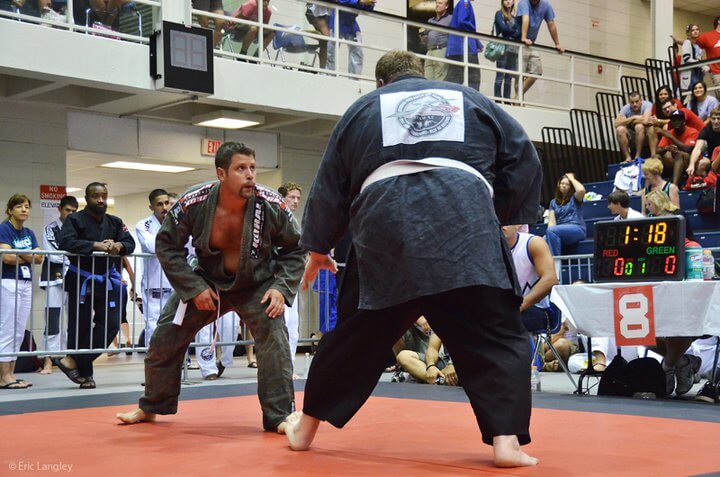“Size Doesn’t Matter…” File this under one of the dumbest myths that martial artists, particularly BJJ practitioners, tell themselves, each other and others. ALL attributes matter in an athletic contest, and dealing with a bigger, stronger adversary with knowledge of how to use that size and strength is inevitably going to suck.
Bearing this in mind, one CAN use jiu-jitsu techniques to successfully overcome size differences, which is a fact we see time and again in absolute divisions where the largest, strongest man doesn’t necessarily win.
Here are 5 ways to get better at handling larger and stronger training partners and opponents:
- Focus on the awfulness. I always hear people devise strategies to avoid dealing with a bigger, stronger person’s attributes, but ones that are good at it will use it. Explore positions and scenarios in which the bigger, stronger practitioner can use their size and strength. For me, when I started starting in bottom side control and trying to figure out how to recover guard or even submit people from there, I began being able to manipulate training partners with significant size and strength advantages. Obviously in a competition you want to avoid places where someone is able to use their attributes successfully, but in training doing this is a great way to learn how to contend with those attributes.
- Limb isolation is key. Learn to recognize opportunities to isolate limbs and do so. Very often if I’m up against someone with a 30+ pound advantage my goal is to get their legs splayed and attack one knee and/or ankle with my entire body. Same thing works with arms and necks. Limb isolation is what makes jiu-jitsu so good as an equalizer. The better you get at finding entries to isolate a limb the better you will be at then controlling that limb and submitting your training partner or opponent.
- Tap early and tap often. More so than training with other kinds of training partners, people with significant size and strength advantages are dangerous to train with just by the nature of their body. It CAN be safe to train with such a person but sometimes you just have to tap to stupid stuff that you normally wouldn’t have to. I have one training partner who is about 30 pounds heavier than I am and is freakishly strong, I often tap to neck cranks that aren’t there yet to avoid him taking them too far. You are responsible for your own safety even if you are rolling with an ogre. Be safe.
- Don’t be afraid to use YOUR attributes. Big people are often slower than smaller people, they use more energy, they naturally leave more space and their dimensions may make it easier to escape certain positions or get into certain crevices that then lead to submission or positional dominance opportunities. Figure out what attributes provide you with advantages when dealing with a training partner or opponent and use them! You may be surprised to find that while someone might be bigger they’re not necessarily stronger or that you have an uncanny ability to maneuver around them because your mobility is better.
- Communicate with all training partners ESPECIALLY the bigger and stronger ones… You are definitely at a greater risk of getting hurt with a bigger, stronger training partner, and even if you’re not at risk of getting hurt, it can be challenging to roll with them. Communicate. Make sure you let them know what you’re trying to do so you can learn from their natural reactions and defenses. If you’re hurt, communicate that as well. Very often training accidents can be prevented by simply speaking up.
One rule that many people don’t follow is to not use size as an excuse. If you get beaten in competition or dominated in the training room by a bigger, stronger person, it’s not “Just because” they’re bigger and stronger, it’s because they use their size and strength well. Learn to handle this. Far too often people forget that the original intention of jiu jitsu was to give the smaller practitioner a chance against a larger adversary. Learn to make your jiu jitsu work for you on those terms.
Rickson Gracie famously said “”If you are not comfortable to deal with an opponent 50 lbs heavier than you, there is something wrong with your Jiu Jitsu.” Apply this in your day to day training regime.

Emil Fischer is a Jiu-jitsu Black Belt and BJJ competitor training under Pablo Angel Castro III at Strong Style MMA in Cleveland Ohio. An avid writer and competitor, Emil has amassed an extensive competition record. Most notably, Emil is a 2 time gold medalist at the IBJJF No Gi Pans, and has a submission victory record of 5-1 at Fight To Win Pro which includes purple belt no-gi light heavyweight championship
Emil’s sponsors are Impact Mouthguards, Cleveland Cryo, The Terphouse, Meerkatsu, Eddys on Coventry and Nottarookie. He is a Ludwig Van and Vanguard Kimono brand ambassador.

